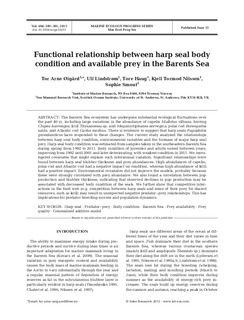| dc.contributor.author | Øigård, Tor Arne | |
| dc.contributor.author | Lindstrøm, Ulf | |
| dc.contributor.author | Haug, Tore | |
| dc.contributor.author | Nilssen, Kjell Tormod | |
| dc.contributor.author | Smout, Sophie | |
| dc.date.accessioned | 2013-10-23T12:13:16Z | |
| dc.date.issued | 2013-06-12 | |
| dc.identifier.citation | Øigård TA, Lindstrøm U, Haug T, Nilssen KT, Smout S (2013) Functional relationship between harp seal body condition and available prey in the Barents Sea. Mar Ecol Prog Ser 484:287-301 | no_NO |
| dc.identifier.issn | 0171-8630 | |
| dc.identifier.issn | 1616-1599 | |
| dc.identifier.uri | http://hdl.handle.net/11250/109223 | |
| dc.description.abstract | The Barents Sea ecosystem has undergone substantial ecological fluctuations over the past 40 yr, including large variations in the abundance of capelin Mallotus villosus, herring Clupea harrengus, krill Thysanoessa sp. and Meganyctiphanes norvegica, polar cod Boreogadus saida, and Atlantic cod Gadus morhua. There is evidence to suggest that harp seals Pagophilus groenlandicus have responded to these changes. The current study analysed the relationships between harp seal body condition, environmental variables and the biomass of major harp seal prey. Harp seal body condition was estimated from samples taken in the southeastern Barents Sea during spring from 1992 to 2011. Body condition of juveniles and adults varied between years, improving from 1992 until 2001 and later deteriorating, with weakest condition in 2011. We investigated covariates that might explain such interannual variation. Significant relationships were found between harp seal blubber thickness and prey abundances. High abundances of capelin, polar cod and Atlantic cod had a negative impact on condition, whereas high abundance of krill had a positive impact. Environmental covariates did not improve the models, probably because these were strongly correlated with prey abundance. We also found a correlation between pup production and blubber thickness, indicating that observed declines in pup production may be associated with decreased body condition of the seals. We further show that competitive interactions in the food web (e.g. competition between harp seals and some of their prey for shared resources, such as krill) may result in unexpected negative predator–prey relationships. This has implications for predator breeding success and population dynamics. | no_NO |
| dc.language.iso | eng | no_NO |
| dc.publisher | Inter-Research | no_NO |
| dc.subject | harp seal | no_NO |
| dc.subject | grønlandssel | no_NO |
| dc.subject | Barents Sea | no_NO |
| dc.subject | Barentshavet | no_NO |
| dc.subject | stock assessment | no_NO |
| dc.subject | bestandsberegning | no_NO |
| dc.title | Functional relationship between harp seal body condition and available prey in the Barents Sea | no_NO |
| dc.type | Journal article | no_NO |
| dc.type | Peer reviewed | no_NO |
| dc.subject.nsi | VDP::Agriculture and fishery disciplines: 900::Fisheries science: 920::Aquaculture: 922 | no_NO |
| dc.description.embargo | 2018-06-12 | |
| dc.source.pagenumber | 287-301 | no_NO |
| dc.source.volume | 484 | no_NO |
| dc.source.journal | Marine Ecology Progress Series | no_NO |
| dc.identifier.doi | 10.3354/meps10272 | |

